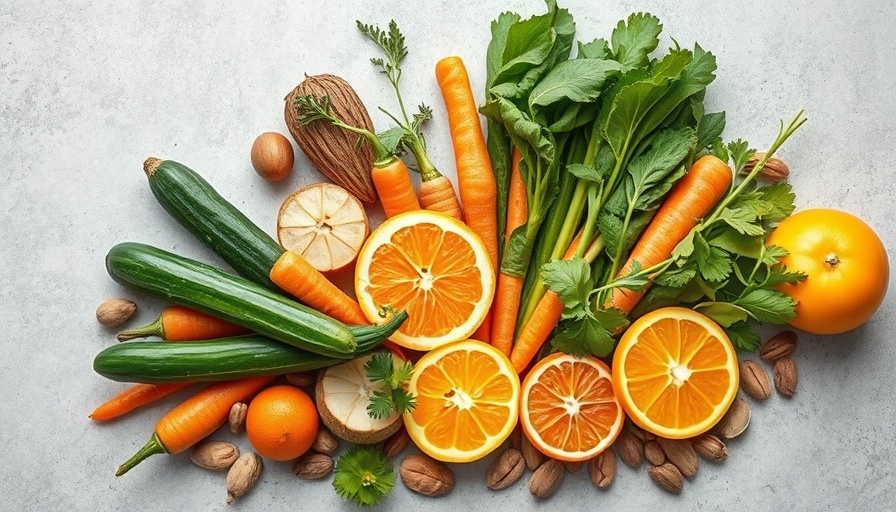
Understanding the Importance of Prebiotics for Gut Health
As we age, maintaining a healthy gut microbiome becomes increasingly important. The gut microbiome consists of trillions of microorganisms that play a crucial role in our overall health, affecting everything from digestion to our immune system. Prebiotics are specialized plant fibers that nourish these good bacteria, helping them thrive and protect our health.
In 'Friday Favorites: How to Keep Your Microbiome Healthy with Prebiotic Foods', the discussion dives into the importance of a fiber-rich diet, exploring key insights that sparked deeper analysis on our end.
Scientific research over the years has highlighted the importance of dietary fiber, leading to a newfound appreciation of prebiotics. These fibers not only support gut bacteria but also contribute to the production of short-chain fatty acids (SCFAs), vital compounds that reduce inflammation and promote beneficial metabolic processes. Thus, integrating prebiotic-rich foods into our daily diets is essential for enhancing our well-being, especially for those aged middle-aged and older.
Embracing a Fiber-Rich Diet for Longevity
Health experts recommend a fiber intake of at least 25-29 grams daily to reap the full benefits of gut health. Unfortunately, statistics indicate that most Americans consume only around 16 grams of fiber per day. For seniors, this lack of fiber can lead to an array of health issues, including constipation, digestive distress, and an increased risk for more severe health outcomes such as heart disease and diabetes.
Incorporating whole food plant-based meals not only elevates fiber intake but also enhances overall nutrition. Foods like beans, lentils, fruits, vegetables, nuts, and whole grains are not only high in fiber but also packed with essential vitamins and minerals, contributing to better energy levels and vitality.
The Link Between Gut Health and Fitness
Good nutrition directly correlates with successful fitness routines. When aiming to maintain or improve fitness, particularly for seniors, eating high-fiber prebiotic foods ensures that energy levels are sustained and that workouts result in greater benefits. By improving digestive health and minimizing inflammation, individuals can engage more effectively in fitness exercises.
For example, a nutrient-rich diet can aid in quicker recovery from workouts. Combining strength training with adequate nutrition help aligns fitness goals with overall health by providing the body with the necessary building blocks for muscle growth and repair.
Energy and Nutrition: A Symbiotic Relationship
From daily energy management to overall wellness, understanding the connection between energy, nutrition, and fitness can make a significant difference in one’s fitness journey. By prioritizing fiber and prebiotics, seniors not only improve their gut health but also experience better energy allocation throughout the day, allowing for mind and body synchronization.
In fact, research indicates that diets rich in fiber, particularly during intense physical activities, can foster resilience against fatigue and irritability while improving overall mood. This energy-boosting potential stems from the ability of SCFAs to affect neurotransmitters linked to happiness.
Fighting Misconceptions: Separating Nutrition Facts from Myths
When adjusting our diets, it is essential to differentiate nutrition myths from facts. For example, many individuals believe that increasing caloric intake guarantees better energy levels. In reality, it is the quality of nutrition that plays a pivotal role. High-calorie junk foods are often devoid of fiber and essential nutrients, leading to increased fatigue and health issues.
Furthermore, it is common to hear claims that high fiber intake can lead to digestive discomfort. However, when introduced gradually and through adequate hydration, high-fiber foods can greatly benefit digestive health without the uncomfortable effects. Thus, approaching dietary changes with informed awareness is crucial.
Actionable Steps to Boost Your Intake of Prebiotic Foods
Wondering how to increase prebiotics in your daily meals? Start by incorporating these simple ideas:
- Add more fruits and vegetables: Aim for a colorful plate! Fruits such as bananas, apples, and avocados, alongside vegetables like artichokes, onions, and broccoli are excellent sources.
- Experiment with whole grains: Instead of white rice or bread, try quinoa, barley, or whole grain pastas that offer higher fiber content.
- Include legumes regularly: Beans, lentils, and chickpeas are not only rich in prebiotics but also make for filling and wonderfully nutritious meals.
Adopting these habits can make a remarkable difference in your gut health while aligning with personal fitness goals.
Conclusion: Prioritizing Your Well-being
Keeping your microbiome healthy with prebiotic foods opens the gateway to better health and longevity, especially for middle-aged and senior individuals. Understanding the vital role fiber plays in this process encourages proactive dietary adjustments that strengthen both body and mind. Let’s not forget, the journey to wellness begins with nourishing your gut, enabling you to live life to the fullest! Incorporate these changes into your nutrition plans, and witness the profound impact on your well-being.
 Add Element
Add Element  Add Row
Add Row 



Write A Comment